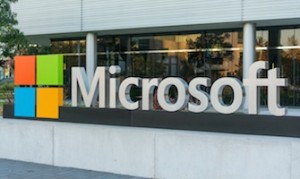 The Microsoft Corporation (NASDAQ:MSFT) of Redmond, WA, is a multinational corporation focused on the development, manufacture and licensing of computer software and other computing products.
The Microsoft Corporation (NASDAQ:MSFT) of Redmond, WA, is a multinational corporation focused on the development, manufacture and licensing of computer software and other computing products.
Having served as CEO of Microsoft for a little over a year, Satya Nadella is seeking to influence innovation at the corporation by increasing the scope of the activities handled by the Microsoft Garage program, a side program which will have an increasingly large responsibility in the company’s product cycle. Products being developed by Microsoft currently include a face-to-face language translator for telecommunications programs like Skype. The corporation is also focused on developing computing solutions for businesses like its Surface Hub large touchscreen technology for conference rooms, which can be scaled up to fit an 84-inch screen.
In his first year of tenure, CEO Nadella has already helped to establish Microsoft as the world’s second-largest company, overtaking Exxon Mobil in November with a $408.9 billion market capitalization. In 2014, Microsoft spent $10.4 billion on research and development activities, the fourth-largest total of any company in the world behind Volkswagen, Samsung and Intel, according to a PricewaterhouseCoopers study. That R&D expenditure total was 13.4 percent of Microsoft’s revenue during that year.
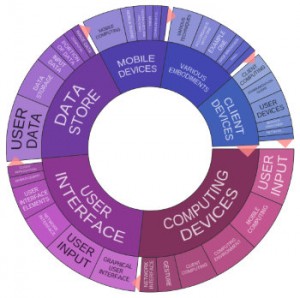 Microsoft pays a premium for R&D but its investment has paid off as the company currently holds one of the world’s strongest patent portfolios. Just recently the company decided to flex this patent muscle in a big way by filing a patent lawsuit against Kyocera; Microsoft is seeking an injunction. The company was 5th overall during 2014 in terms of patents granted by the U.S. Patent and Trademark Office with 2,829 U.S. patents last year. That’s a slight rise from Microsoft’s 2,814 U.S. patents in 2013, which was good for a 6th place finish in that year. Our work with Innography’s patent analysis tools shows a significant discrepancy in Microsoft’s 2014 IP grants with 3,284 U.S. patents, but that’s likely due to differences in how subsidiary patents are tallied; the Innography numbers tallied both Microsoft Corporation and Microsoft Technology Licensing patents. As our readers can see in the accompanying text cluster, much of Microsoft’s 2014 patent grants protected technology related to computing devices, mobile devices and user interfaces.
Microsoft pays a premium for R&D but its investment has paid off as the company currently holds one of the world’s strongest patent portfolios. Just recently the company decided to flex this patent muscle in a big way by filing a patent lawsuit against Kyocera; Microsoft is seeking an injunction. The company was 5th overall during 2014 in terms of patents granted by the U.S. Patent and Trademark Office with 2,829 U.S. patents last year. That’s a slight rise from Microsoft’s 2,814 U.S. patents in 2013, which was good for a 6th place finish in that year. Our work with Innography’s patent analysis tools shows a significant discrepancy in Microsoft’s 2014 IP grants with 3,284 U.S. patents, but that’s likely due to differences in how subsidiary patents are tallied; the Innography numbers tallied both Microsoft Corporation and Microsoft Technology Licensing patents. As our readers can see in the accompanying text cluster, much of Microsoft’s 2014 patent grants protected technology related to computing devices, mobile devices and user interfaces.
[Companies-1]
Microsoft’s Issued Patents: From Mixed Reality Environments to Parking Space Search
Innovations with an eye towards better business services have been a focus for Microsoft and we were intrigued by the technology we saw reflected by U.S. Patent No. 8959109, which is titled Business Intelligent In-Document Suggestions. The computer-implemented method protected here involves detecting added or selected content in a document, generating a query based on that content, submitting the query to a search engine service, receiving search results and integrating the results in a document user interface; the results could include people, documents or statistics associated with the content. This system is designed to improve document collaboration by unifying an enterprise’s searching and authoring activities when generating documents related to personnel or products.
Augmented reality technologies are always an interesting find here in the Companies We Follow series so we wanted to make sure to share a pair of Microsoft patents recently issued in this field. Techniques for increasing the accuracy of pinpointing a mixed reality device user’s location to provide better street-level services are discussed by U.S. Patent No. 8943420, issued under the title Augmenting a Field of View. The patent claims a method for enhancing an experience associated with a field of view of a local environment by capturing an image depicting a view of a local environment including a set of entities, displaying the image depicting the local environment view, identifying a correlation between an entity included in the view and a corresponding modeled entity included in a 3D geospatial model, defining boundaries of the modeled view of the geospatial model and selecting and presenting additional content corresponding to an entity which isn’t in the image. This system is intended to improve upon GPS-based systems to generate greater understanding of a user’s real context. Tools for creating an augmented reality that incorporates the background of a 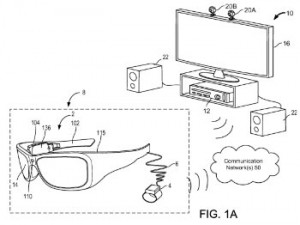 physical location other than the one in which they are currently located is at the center of U.S. Patent No. 8963956, which is titled Location Based Skins for Mixed Reality Displays. This Microsoft patent claims a method of transmitting location identifier information to a skin providing computer system, receiving a skin associated with the location at a head mounted mixed reality display device system and displaying an authenticated skin in the mixed reality device so that a virtual object can be associated with a real object in a user’s field of view. Diagrams attached to this patent seem to indicate that a computing system could be used to capture a field of view from a physical location and transmit that view to a head-mounted device.
physical location other than the one in which they are currently located is at the center of U.S. Patent No. 8963956, which is titled Location Based Skins for Mixed Reality Displays. This Microsoft patent claims a method of transmitting location identifier information to a skin providing computer system, receiving a skin associated with the location at a head mounted mixed reality display device system and displaying an authenticated skin in the mixed reality device so that a virtual object can be associated with a real object in a user’s field of view. Diagrams attached to this patent seem to indicate that a computing system could be used to capture a field of view from a physical location and transmit that view to a head-mounted device.
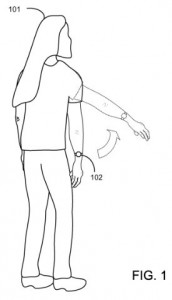 Another couple of recently issued patents showcase Microsoft’s advances in developing video gaming and digital entertainment systems for consumers. Video gaming technologies for physical fitness activities have already been developed by others but Microsoft has been developing its own products in this field, as is evidenced by U.S. Patent No. 8951164, entitled Extending Gameplay With Physical Activity Monitoring Device. The method of augmenting a gaming experience claimed here involves receiving at a physical activity monitoring device an indication of physical activities to be performed as an extension of a game being played on a game system, measuring physical activity attributes of a user with the monitoring device, determining a user’s progress towards completion of a physical activity, determining the number of repetitions of a repetitive physical activity that have been completed by the user and outputting the user’s progress to the game system. The creation of a system that allows a person viewing digital content to leverage their watching of advertisements in order to gain access to more content is disclosed and protected by U.S. Patent No. 8955006, which is titled Entertainment Content Purchase Via Advertising Viewing Credit. The patent claims a method of providing audio and/or video entertainment content to a user over a network by providing an advertising content item to a user, awarding an amount of advertising credit to the user based on the advertising content being viewed, receiving a request from the user to view an entertainment content item, verifying that the user has earned a sufficient level of advertising viewing credits to pay for the entertainment content, sending the entertainment content to the user and deducting advertising viewing credits in exchange; if the user doesn’t have enough viewing credits, he or she is presented with an option to view a portion of the content without advertisements or presenting additional advertisements to watch. This innovation is intended to encourage users to view content without having to commit to paying out-of-pocket for access to selected entertainment.
Another couple of recently issued patents showcase Microsoft’s advances in developing video gaming and digital entertainment systems for consumers. Video gaming technologies for physical fitness activities have already been developed by others but Microsoft has been developing its own products in this field, as is evidenced by U.S. Patent No. 8951164, entitled Extending Gameplay With Physical Activity Monitoring Device. The method of augmenting a gaming experience claimed here involves receiving at a physical activity monitoring device an indication of physical activities to be performed as an extension of a game being played on a game system, measuring physical activity attributes of a user with the monitoring device, determining a user’s progress towards completion of a physical activity, determining the number of repetitions of a repetitive physical activity that have been completed by the user and outputting the user’s progress to the game system. The creation of a system that allows a person viewing digital content to leverage their watching of advertisements in order to gain access to more content is disclosed and protected by U.S. Patent No. 8955006, which is titled Entertainment Content Purchase Via Advertising Viewing Credit. The patent claims a method of providing audio and/or video entertainment content to a user over a network by providing an advertising content item to a user, awarding an amount of advertising credit to the user based on the advertising content being viewed, receiving a request from the user to view an entertainment content item, verifying that the user has earned a sufficient level of advertising viewing credits to pay for the entertainment content, sending the entertainment content to the user and deducting advertising viewing credits in exchange; if the user doesn’t have enough viewing credits, he or she is presented with an option to view a portion of the content without advertisements or presenting additional advertisements to watch. This innovation is intended to encourage users to view content without having to commit to paying out-of-pocket for access to selected entertainment.
Microsoft is even involved in trying to help drivers find useful parking spaces more rapidly, as is evidenced by U.S. Patent No. 8963740, entitled Crowd-Sourced Parking Advisory. The system disclosed here includes an access component that accesses parking-related geolocation data of users that have parked or are searching for parking in a geographical area, a statistical computation component that computes parking availability probabilities for parking in the area, a presentation component that presents the parking availability probabilities to a user searching for a parking space and a microprocessor that executes instructions associated with those components. This system can incorporate data from social networks, event websites, construction notification websites and others to improve the accuracy of determining parking availability in an area.
Patent Applications of Note: More Mixed Reality Tech and Safe Driving Modes for Mobile Devices
As we’re finding in our survey of Microsoft inventions, improvements to user interfaces comprise a fair amount of the company’s R&D activities. An interface for viewing photographs on mobile devices which takes into greater account the data collected by mobile device sensors is described within U.S. Patent Application No. 20150002393, which is titled Natural User Interfaces for Mobile Image Viewing. The patent application would protect a computer-implemented process for viewing imagery on a mobile device by tracking the device’s orientation and position, using a camera and a viewer tracker to track the user’s face relative to the device’s screen and computing image transformations of the displayed imagery to allow dynamic change of the imagery’s perspective relative to the user’s face. This innovation creates a hands-free system for viewing large images, like panoramas or parallax image sequences. Improved touch interactions, specifically the ability to impart tactile feedback to a user, on wall-sized touchscreens similar to Microsoft’s Surface Hub are the focus of U.S. Patent Application No. 20140380156, which is titled Infrastructural Haptics on Wall Scale Interactive Displays. The patent application claims a method executed by a computing device that involves displaying a user interface with touch-based control elements on an interactive wall, detecting a touch on the interactive wall’s surface, reporting the detected touch to a control server, receiving a tactile feedback corresponding to the touch and playing the tactile feedback through agitators integrated to the interactive wall. This system could provide various tactile feedback to different touch events, including clicks, dragging motions, button presses and more.
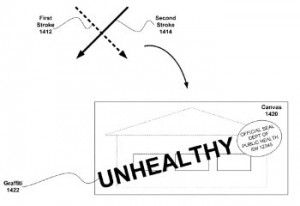 More virtual reality technologies were presented by a pair of patent applications that we came across in our search today. The superimposition of certain imagery onto a digital canvas through a series of gestures is outlined by U.S. Patent Application No. 20150022549, entitled System and Method for Converting Gestures Into Digital Graffiti. The portable device claimed here includes a motion component that outputs motion information corresponding to device movement, a directional component that outputs direction location based on the device’s pointing direction and at least one processor to superimpose digital graffiti generated by a gesture onto a digital canvas corresponding to a plurality of points of interest. As the patent application explains, this system could be used to provide a user with feedback on an entity of interest in response to a gesture like pointing at that entity. The augmentation of a physical field of view being watched via a see-through display for better viewing of dark spaces is discussed within U.S. Patent Application No. 20150035832, filed under the title Virtual Light in Augmented Reality. The head-mounted display system that would be protected includes an optical sensor system that observes a physical environment, a position sensor system that assesses the perspective of the optical sensor system and a see-through display that visually augments the appearance of a physical environment by creating the illusion of a virtual shadow of a virtual object by virtually illuminating a non-shadow region bordering the shadow.
More virtual reality technologies were presented by a pair of patent applications that we came across in our search today. The superimposition of certain imagery onto a digital canvas through a series of gestures is outlined by U.S. Patent Application No. 20150022549, entitled System and Method for Converting Gestures Into Digital Graffiti. The portable device claimed here includes a motion component that outputs motion information corresponding to device movement, a directional component that outputs direction location based on the device’s pointing direction and at least one processor to superimpose digital graffiti generated by a gesture onto a digital canvas corresponding to a plurality of points of interest. As the patent application explains, this system could be used to provide a user with feedback on an entity of interest in response to a gesture like pointing at that entity. The augmentation of a physical field of view being watched via a see-through display for better viewing of dark spaces is discussed within U.S. Patent Application No. 20150035832, filed under the title Virtual Light in Augmented Reality. The head-mounted display system that would be protected includes an optical sensor system that observes a physical environment, a position sensor system that assesses the perspective of the optical sensor system and a see-through display that visually augments the appearance of a physical environment by creating the illusion of a virtual shadow of a virtual object by virtually illuminating a non-shadow region bordering the shadow.
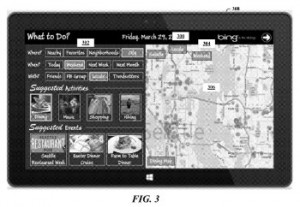 Technologies that encourage socializing were reflected in another pair of patent applications that came across our desk. A system for suggesting activities for a predetermined period of time based on social data would be protected by U.S. Patent Application No. 20150058345, which is titled Realtime Activity Suggestion From Social and Event Data. The system claimed here utilizes an aggregation component that receives geographically-referenced social and event data with a spatial extent for a span of time, a suggestion component that suggests activities in the spatial extent to a user and at least one microprocessor to execute instructions associated with those components. This system allows a user to compare different localities or times to determine which is best for a certain activity, from eating to recreational activities. Methods of increasing privacy in communications which are taking place in crowded locations are discussed by U.S. Patent Application No. 20150057999, entitled Preserving Privacy of a Conversation From Surrounding Environment. The computer-implemented method that would be protected involves receiving an audio input signal intended for one or more recipients, analyzing the signal to generate a counter signal and sending the counter signal outward from the device to modify audible acoustic effects proximate to the device. This system would enable a person to engage in a private conversation through a mobile phone or laptop computer while out at a public place, like a coffee shop.
Technologies that encourage socializing were reflected in another pair of patent applications that came across our desk. A system for suggesting activities for a predetermined period of time based on social data would be protected by U.S. Patent Application No. 20150058345, which is titled Realtime Activity Suggestion From Social and Event Data. The system claimed here utilizes an aggregation component that receives geographically-referenced social and event data with a spatial extent for a span of time, a suggestion component that suggests activities in the spatial extent to a user and at least one microprocessor to execute instructions associated with those components. This system allows a user to compare different localities or times to determine which is best for a certain activity, from eating to recreational activities. Methods of increasing privacy in communications which are taking place in crowded locations are discussed by U.S. Patent Application No. 20150057999, entitled Preserving Privacy of a Conversation From Surrounding Environment. The computer-implemented method that would be protected involves receiving an audio input signal intended for one or more recipients, analyzing the signal to generate a counter signal and sending the counter signal outward from the device to modify audible acoustic effects proximate to the device. This system would enable a person to engage in a private conversation through a mobile phone or laptop computer while out at a public place, like a coffee shop.
 Finally, we were greatly intrigued to note a Microsoft innovation which is intended to promote safe driving among owners of electronic devices. U.S. Patent Application No. 20150011203, filed under the title Mobile Device Safe Driving, claims a method of receiving an unsafe driving notification of an unsafe driving event which is generated responsive to a movement of a vehicle being driven, determining a mobile device associated with a driver and communicating with the mobile device to cause activation of a safe driving mode. The safe driving mode established by this innovation is intended to reduce instances of distracted driving caused by mobile device use, which is especially problematic among teenage drivers.
Finally, we were greatly intrigued to note a Microsoft innovation which is intended to promote safe driving among owners of electronic devices. U.S. Patent Application No. 20150011203, filed under the title Mobile Device Safe Driving, claims a method of receiving an unsafe driving notification of an unsafe driving event which is generated responsive to a movement of a vehicle being driven, determining a mobile device associated with a driver and communicating with the mobile device to cause activation of a safe driving mode. The safe driving mode established by this innovation is intended to reduce instances of distracted driving caused by mobile device use, which is especially problematic among teenage drivers.

![[IPWatchdog Logo]](https://ipwatchdog.com/wp-content/themes/IPWatchdog%20-%202023/assets/images/temp/logo-small@2x.png)

![[Advertisement]](https://ipwatchdog.com/wp-content/uploads/2024/04/Artificial-Intelligence-2024-REPLAY-sidebar-700x500-corrected.jpg)
![[Advertisement]](https://ipwatchdog.com/wp-content/uploads/2024/04/UnitedLex-May-2-2024-sidebar-700x500-1.jpg)
![[Advertisement]](https://ipwatchdog.com/wp-content/uploads/2024/04/Patent-Litigation-Masters-2024-sidebar-700x500-1.jpg)

![[Advertisement]](https://ipwatchdog.com/wp-content/uploads/2021/12/WEBINAR-336-x-280-px.png)
![[Advertisement]](https://ipwatchdog.com/wp-content/uploads/2021/12/2021-Patent-Practice-on-Demand-recorded-Feb-2021-336-x-280.jpg)
![[Advertisement]](https://ipwatchdog.com/wp-content/uploads/2021/12/Ad-4-The-Invent-Patent-System™.png)






Join the Discussion
One comment so far.